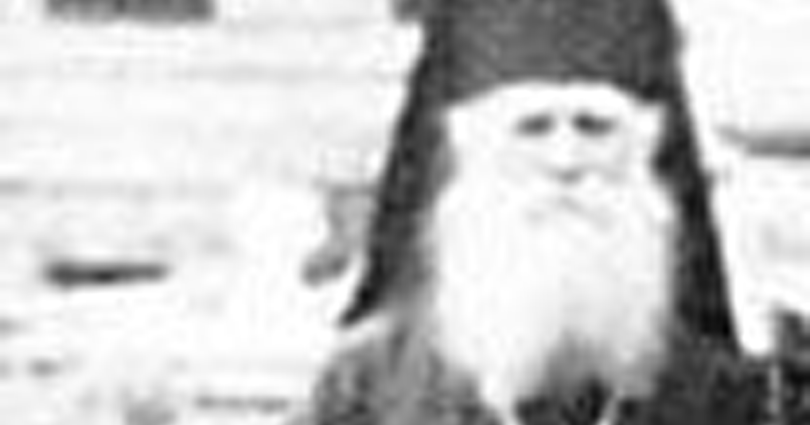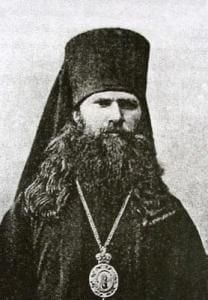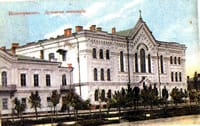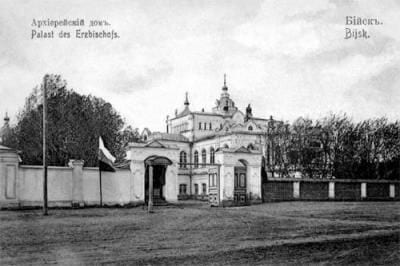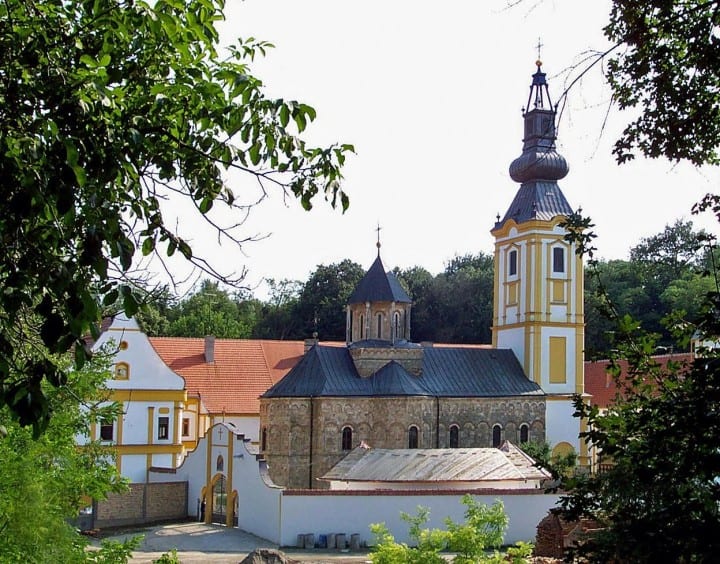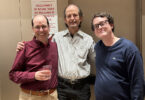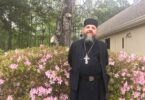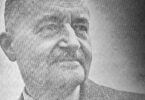Archbishop Sergey (Stepan Alexeevich Petrov, 30 Jan 1864-11/24 Jan 1935)
Stepan Alexeevich Petrov was born in the Don Cossack stanitsa (village) of Aksai on 30 Jan 1864. The area was home to Scythians and Kurgans in ancient times; somewhat later came the Khazars and Polovtsy.[1]en.wikipedia.org/wiki/Don_Cossacks Local legend has it that the hero of The Lay of Igor’s Campaign, Prince Igor Svyatoslavich, was vanquished on the field of battle by the Turkic Polovtsy and their leader, Khan Kobyak, in the area. [2]www.aksayland.ru/[3]en.wikipedia.org/wiki/The_Tale_of_Igor’s_Campaign
Aksai stanitsa, on the steep right bank of the Don at its confluence with the River Aksai,[4]op. cit. 2 was settled within a few decades from the time that the Don Cossacks came into the area. The first record of a Don Cossack stanitsa dates from 1549,[5]op. cit. 1 while the first record of the Aksai stanitsa dates from 1570.[6]op. cit. 2 The name changed throughout the early years, from Aksai mill, to Ust’ Aksai mill, then finally, simply Aksai in 1791.[7]ibid. Legends, tales and true stories of the glories, conquests, battles, raids and victories of the Don Cossacks were certainly part of the childhood fare of the future Archbishop Sergei.
The future Archbishop Sergei’s parents were both pious Orthodox Christians, and imbued their son with a deep and abiding respect for the Church, and most especially the clergy.[8]http://www.synod.com/01newstucture/pagesru/novosti2005/archsergiy.html The fact that Stepan Alexeevich had an uncle [9]ibid. who was an archimandrite and Head of the Altai Mission (from 1867 to1883; Archimandrite Vladimir –Ivan Stepanovich Petrov, 29 Apr 1858-02 Sep 1897, later Bishop of Biisk; Tomsk & Semipalatinsk; Stavropol; Archbishop of Nizhny Novgorod [10]http://www.ortho-rus.ru/cgi-bin/ps_file.cgi?2_847), as well as another uncle, Hieromonk Antony (Petrov, brother of Archimandrite Vladimir) who served the Altai Mission as an iconographer [11]http://www.pravenc.ru/text/115104.html is obviously at least partly responsible for their great respect for the clergy. Alexey Petrov, the future Archbishop Sergei’s father, as well as his grandfather, served as a prichetnik (a term not easily rendered into English, meaning someone who belongs to причт, “Church servers,” in large Cathedral parishes, usually a paid position; the term could cover anyone “working” in a parish: the rector, deacon, subdeacon, ecclesiarch, choir director and members, readers, altar servers, sacristan, prosphora bakers, bell-ringers, janitors, groundskeepers, gravediggers . . . all had to be approved by the Diocesan Bishop [12]Facebook message, 30 Oct 2010, from Viktor Skuratovskiy) and undoubtedly prepared his son for a life of service to the Church.
Long part of the Voronezh Diocese, the Holy Synod created the Diocese of Novocherkassk & Georgievsk in 1829 for the lands of the Don Cossacks. The name of the Diocese was changed in 1842 to “of the Don & Novocherkassk.” [13]http://www.pravenc.ru/text/178954.html “Throughout the first half of the 19th century, the problem of spiritual education was one of the most painful for the newly formed (1829), Don diocese.” [14]http://www.rmdu.ru/history/history3/ To procure a proper education to serve the Church as clergy, prospective candidates had to travel outside the Don lands, primarily to Voronezh. Such an education was very expensive, and it was a rare occurrence that a family could afford it. Many of the clergy had failed to finish their education at “county schools” to take up причт posts, and through those posts gaining an education for clerical positions. It was lamented that this “could not but affect the moral and intellectual level of the Don clergy.” [15]ibid. Many priests had no spiritual education or background, and even those who had both “did not last long.” [16]ibid. By 1840, out of 600 clergy in the Diocese, only 72 had attended Seminary. [17]ibid.
Upon the founding of the new Diocese in 1829, the first Ruling Hierarch, Bishop Afanassy (Alexander Ivanovich Teliatev, 1772-07 May 1847),[18]http://www.ortho-rus.ru/cgi-bin/ps_file.cgi?2_2647 donated his entire library for a future Diocesan Seminary. [19]op. cit. 14 Founding an institution for spiritual education in 19th century Russia was no easy task. Governmental authorities needed to be convinced, financing secured, and the “inertia of spiritual authorities and the indecision of the clergy” [20]op. cit. 14 were not insignificant obstacles to overcome. Archbishop John (Mikhail Stepanovich Dobrozrakov, 1790-1872) of Don and Novocherkassk [21]http://www.ortho-rus.ru/cgi-bin/ps_file.cgi?2_4665 made a detailed proposal to the Procurator of the Holy Synod concerning the establishment of a Seminary in Novocherkassk, but his proposal never found its way to the Holy Synod. [22]op. cit. 14 Finally, Archbishop Platon (Mikhail Ivanovich Gorodetsky, 1803-1891, later Metropolitan of Kiev & Galich) of Don and Novocherkassk, [23]http://www.ortho-rus.ru/cgi-bin/ps_file.cgi?2_4897 after significant labors and sheer force of will, at last prevailed over the problems mentioned above, and the Don Theological Seminary opened on 08 July 1868, ending nearly 40 years of a complete absence of a means for educating clergy in the Diocese. [24]op. cit. 14
By the 1890’s, the majority of the clergy of the Don & Novocherkassk Diocese had attended the Diocesan Seminary, greatly elevating the moral level of the clergy, and eradicating the stereotype of the Don Cossack priest who had never studied, had low moral standards, and was a sympathizer with Old Believers. The Don Theological Seminary also graduated a number of clergy who joined the choir of the Holy New Martyrs of Russia. [25]op. cit. 14 Stepan Alexeevich Petrov, the future Archbishop Sergei, graduated from the Don Theological Seminary in 1886. [26]op. cit. 8
Despite the best hopes of the founders of the Don Seminary, and the youthful desire to follow his relatives into monasticism, Stepan Alexeevich Petrov, while at the Seminary, suffered a “spiritual malaise” and a “mental oppression” that threatened to make him abandon all thoughts of service to the Church. [27]op. cit. 8 As a sort of last hope to overcome these difficulties, Stefan Alexeevich decided to move to Tomsk, where his uncle, former Archimandrite of the Altai Mission, was Bishop Vladimir (Petrov) of Tomsk and Semipalatinsk, and place himself under his uncle’s guidance.27 These hopes seemed unfulfilled, when, in a moment of complete despair, he heard (in his mind) a Church hymn from his childhood, “Trust ye not in princes, in the sons of men, in whom there is no salvation . . .” [28]op. cit. 8[29]http://pomog.org/index.html This internal experience began a turning point in his spiritual life, and closely coincided with an external experience-meeting several of the laborers from the Altai Mission. Their very appearance seemed completely different to him than that of “ordinary mortals,” and the stories of their labors seemingly mapped out his future path-preaching the Word of God to the Altai peoples. He left Tomsk and went to Moscow, where he enrolled in the Historical-Philological Faculty of the Moscow University (the study of historical and comparative linguistics, in preparation for his work in the Altai Mission), from which he graduated in 1890 with a diploma of the 1st Degree.[30]op. cit. 8
After his graduation from Moscow University, he attended lectures at the Kazan Theological Academy for further preparation to serve the Altai Mission. He also finally decided to embrace monasticism, and joined the Mission. In 1892, he was tonsured a monk with the name “Sergei,” and on 07 Nov of that year, ordained Hieromonk, and appointed as Assistant Director of the Kirghiz Mission (a “department” of the Altai Mission). By the time that the newly ordained Hieromonk Sergei (Petrov) was serving in the Altai Mission, the Mission already had a long and illustrious history. Founded in 1830, the Altai Spiritual Mission was the most famous, and most successful missionary effort of the Russian Orthodox Church in the 19th century. It adhered to the most notable principle of the Holy Equals to the Apostles and Enlighteners of the Slavs, Saints Kirill and Mefodii, that is, missionary efforts and translations of services, Scripture, and other necessary materials into the vernacular language of the subjects of the missionary efforts. At the Irkutsk Missionary Congress of 1910, the Altai Mission was recognized as a “model and leader” for all other missions. The greatest strengths of the Altai Mission were education, translations, literary and publishing efforts, and ethnographic studies. Another factor in the success of the Mission was the fact that they did not merely baptize, but supervised the spiritual life of the newly baptized Orthodox Christians. In less than a century, from 1820 to 1910, more than half of the indigenous peoples of the Altai were drawn from paganism to Orthodoxy. [31]op. cit. 11
The great success of the Altai Spiritual Mission can be credited to its first director, Archimandrite Makary (Glukharev, +1847, Glorified as Saint Makary, Apostle of the Altai, by the Jubilee Hierarchical Council of the Russian Orthodox Church in 2000), Director of the Mission from 1839 to 1844 [32]http://www.ortho-rus.ru/cgi-bin/ps_file.cgi?3_6192 & http://ru.wikipedia.org/wiki/Макарий_(Глухарёв), who laid down the principles that ensured its successes. These principles included, as well as the above, love, compassion, material aid to the poor, and learning the customs and beliefs of the peoples they preached the Orthodox Faith to. [33]op. cit. 11 In 1864 the Mission consisted of 9 missionaries and 29 interpreters. Along with missionary efforts, the nomadic Altai peoples were settled, taught farming and horticulture, they were vaccinated against smallpox, among other medical treatments, and food, clothing, farming equipment, livestock, and housing had to be supplied for many.[34]op. cit. 11 The efforts of the Missionaries and their assistants, while not without reward, could often be extremely dangerous: traversing cliffs, mountains, icy rivers, swamps, during rainstorms and blizzards, attacks by Moslems embittered about the success of the Mission, and being robbed by escaped convicts. [35]http://www.ortho-rus.ru/cgi-bin/ps_file.cgi?2_296 The most famous director of the Mission was Archimandrite Makary (Mikhail Andreevich Nevsky, 1835-1926, later Metropolitan of Moscow and All Russia, Glorified as Saint Makary, Apostle of the Altai, by the Jubilee Hierarchical Council of the Russian Orthodox Church in 2000), [36]op. cit. 11 who continued and increased the successes of the Mission, especially in the areas of translations and the printing of the Divine Services and Scriptures in the languages of the Altai peoples. [37]http://www.ortho-rus.ru/cgi-bin/ps_file.cgi?2_850
Hieromonk Sergei (Petrov) labored with the Altai Mission for 11 years; from the above, it can be assumed that those 11 years were possibly the happiest, as well as most rewarding of his life, but also a most difficult life, filled with hardships, deprivations, and dangers. In 1899, Hieromonk Sergei was appointed Director of the Altai Mission, and also called to Hierarchical Service, and was consecrated as Bishop of Biisk, Vicar of the Diocese of Tomsk Diocese. The consecration took place in the church at the Episcopal residence in Tomsk. Presiding over the services was Bishop Makary (Nevsky) of Tomsk & Barnaulsk (the name had been changed from “of Tomsk & Semipalatinsk” in 1895), assisted by Bishop Mefody (Mavriki Lvovich Gerasimov, 1856-1931, later Metropolitan of Harbin & Manchuria for the ROCOR) of Zabaikal & Nerchinsk, and Bishop Innokenty (Ivan Apollonovich Figurovsky, 1863-1932, later Metropolitan of Peking & China for the ROCOR) of Priamursk & Blagoveshchensk. Biisk was the home of the administrative headquarters of the Altai Mission. The Biisk Vicariate of the Tomsk Diocese was established in 1880, and the third head of the Altai Mission, Archimandrite Vladimir (Petrov, Archbishop Sergei’s uncle), was consecrated then as the first Bishop of Biisk. The Bishops of Biisk were also the Directors of the Altai Mission-during his tenure as Bishop of Biisk, Bishop Sergei concurrently served as Director of the Altai Mission. [38]ibid.
As was the usual practice in the Russian Church at the time, Bishop Sergei did not remain as Bishop of Biisk for long. In 1901, he was appointed Bishop of Omsk & Semipalatinsk; 1903, Bishop of Kovensk, Vicar of the Litovsk Diocese; 1907, Bishop of Novomirgorod, Vicar of the Kherson Diocese; 1913, Bishop of Sukhumi, and thereafter Bishop of Chernomorsk and Novorosiisk (The word “Chernomorsk” in Bishop Sergei’s title has often been translated into English as “Black Sea;” he was, of course, not “Bishop of the Black Sea,” the word refers to the Black Sea province of the Russian Empire). [39]http://ru.wikipedia.org/wiki/ The 1897 Census of the Black Sea Province recorded 57,478 people, representing 45 nationalities, the most numerous being: Great Russians; Ukrainians; Greeks; Armenians; Jews; Moldavians; Georgians; Circassians; Czechs; Estonians; and Belorussians. Subsequent census figures for the province record a population of 70,000 in 1905, and 202,000 in 1917. [40]ibid.
From 1896 to 1920, Novorossiisk was the capital of the Black Sea Province. The city went through the trials and tribulations that the entirety of Russia experienced in the early 20th century. In 1905, a general strike was called, virtually every business and service in the city was shut down, and a Council of Workers Deputies chose 72 delegates, urging the people to “fight against weakening tsarism.” The city was besieged by Russian troops, who eventually prevailed, and finally the Workers Deputies were arrested, many sentenced to hard labor, seven sentenced to death. A return to normalcy followed, and business as usual was the order of the day until 1917. In October of 1917, a Revolutionary Committee was elected, dominated by bolsheviks, as the mensheviks and other socialist parties refused to participate. In late November 1917, the Provisional Government gained power in the region. This was short lived, as Soviet power was established in December. In May 1917, German and Turkish naval squadrons gained some control of the city, and by August, the Western Allies were in control, and the White Army was charged by the bolsheviks with a massacre against the Red Army soldiers caught in the city. March of 1919 saw a resurgence of Red Army guerilla activity, but by March 1920 the White Army was in control, arranging evacuations-General Denikin left Russia from the port of Novorossiisk. May 1920, Baron Wrangel’s troops enaged in battle with the Red Army, a lengthy proposition which resulted in the final defeat of the White Armies. Wrangel and some of his troops evacuated, those who could not evacuate “disappeared” into the countryside.” [41]www.rocorstudies.org/test: see biography of Bishop Mikhail (Kosmodamiansky), about the 1919 Southeast Russian Church Council
If Bishop Sergei (Petrov) was present for any of the events mentioned above, we do not know. He was, however, a participant in the All Russian Council held in Moscow in 1917-1918, and also the Southeast Russian Church Council in Stavropol, 19-24 May 1919. Bishop Sergei cooperated with the Southeast Russian Church Council, and the Higher Church Authority under the Presidency of Metropolitan Antony (Alexei Pavlovich Khrapovistky, 1863-1936, later first Chief Hierarch of the ROCOR), which the Council established. [42]http://en.wikipedia.org/wiki/Privina_Glava_monastery & en.wikipedia.org/wiki/Patriarch_Varnava_of_Serbia In 1920, Bishop Sergei was evacuated from Russia, and went first to Constantinople, and thereafter to Yugoslavia, where he participated in the Karlovtsy Council of 1921 which established the ROCOR. During his time in Yugoslavia, the ROCOR elevated him to Archbishop. He assisted with the administration of the ROCOR, but soon went to live in the Serbian Monastery Privina Glava. The Monastery is located in the Fruska Gora mountains in northern Serbia. While there is a claim the Monastery was founded in the 12th century, earliest historical records are dated from 1566/1567. The Monastery is dedicated to the Holy Archangels Michael & Gabriel. [43]op. cit. 8
Always suffering rather poor health, from the autumn of 1934, Archbishop Sergei noticeably declined. After the Nativity of the Lord, 1934, never left the monastery enclosure. He was usually found sitting in a chair, reading Scripture, and commented that he thought he knew the Scriptures, but always found something new, as well as more beauty, in them. Well educated, master of many foreign languages, he was interested in the whole world until his last day of his life, especially any news of Russia. Only two days before his death, Archbishop Sergei bean to feel better. He made plans for the future days, read an article in Church Life by Archbishop Anastassy (Alexander Alexeevich Gribanovsky, 1873-1965, later second Chief Hierarch of the ROCOR) of Kishinev, and fell to recollections-of his parents, his mother, who he lost at a young age, Aksai stanitsa, the Don, the endless expanse of the blue steppe, the miles of meadows covered in floods . . . The morning of 11/24 Jan 1935 found Archbishop Sergei cheerful, and in a rather loud voice, reading verses by Count Alexei Tolstoi. A short while later, a monk found him dead. [44]op. cit. 8
On 12/25 Jan 1935, the burial of Archishop Sergei (Petrov) took place at the Privina Glava Monastery. Presiding were Archbishop Anastassy (Gribanovsky), and Archbishop Feofan (Feodor Georgievich Gavrilov, 1872-1943) of Kursk & Oboyansk, concelebrating were several Russian and Serbian clergy. [45]op. cit. 8 With the blessing of the Serbian Patriarch Varnava (Varnava Rosich, 1880-1937), [46]en.wikipedia.org/wiki Archbishop Sergei was buried in the Monastery church yard, near the walls of the Monastery. [47]op. cit. 8 Memory Eternal!
- http://www.bigpi.biysk.ru/museum/photogallery.ph
- http://www.sedmitza.ru/text/430289.html
- http://en.wikipedia.org/wiki/Privina_Glava_monastery
References
| ↵1 | en.wikipedia.org/wiki/Don_Cossacks |
|---|---|
| ↵2 | www.aksayland.ru/ |
| ↵3 | en.wikipedia.org/wiki/The_Tale_of_Igor’s_Campaign |
| ↵4 | op. cit. 2 |
| ↵5 | op. cit. 1 |
| ↵6 | op. cit. 2 |
| ↵7 | ibid. |
| ↵8 | http://www.synod.com/01newstucture/pagesru/novosti2005/archsergiy.html |
| ↵9 | ibid. |
| ↵10 | http://www.ortho-rus.ru/cgi-bin/ps_file.cgi?2_847 |
| ↵11 | http://www.pravenc.ru/text/115104.html |
| ↵12 | Facebook message, 30 Oct 2010, from Viktor Skuratovskiy |
| ↵13 | http://www.pravenc.ru/text/178954.html |
| ↵14 | http://www.rmdu.ru/history/history3/ |
| ↵15 | ibid. |
| ↵16 | ibid. |
| ↵17 | ibid. |
| ↵18 | http://www.ortho-rus.ru/cgi-bin/ps_file.cgi?2_2647 |
| ↵19 | op. cit. 14 |
| ↵20 | op. cit. 14 |
| ↵21 | http://www.ortho-rus.ru/cgi-bin/ps_file.cgi?2_4665 |
| ↵22 | op. cit. 14 |
| ↵23 | http://www.ortho-rus.ru/cgi-bin/ps_file.cgi?2_4897 |
| ↵24 | op. cit. 14 |
| ↵25 | op. cit. 14 |
| ↵26 | op. cit. 8 |
| ↵27 | op. cit. 8 |
| ↵28 | op. cit. 8 |
| ↵29 | http://pomog.org/index.html |
| ↵30 | op. cit. 8 |
| ↵31 | op. cit. 11 |
| ↵32 | http://www.ortho-rus.ru/cgi-bin/ps_file.cgi?3_6192 & http://ru.wikipedia.org/wiki/Макарий_(Глухарёв) |
| ↵33 | op. cit. 11 |
| ↵34 | op. cit. 11 |
| ↵35 | http://www.ortho-rus.ru/cgi-bin/ps_file.cgi?2_296 |
| ↵36 | op. cit. 11 |
| ↵37 | http://www.ortho-rus.ru/cgi-bin/ps_file.cgi?2_850 |
| ↵38 | ibid. |
| ↵39 | http://ru.wikipedia.org/wiki/ |
| ↵40 | ibid. |
| ↵41 | www.rocorstudies.org/test: see biography of Bishop Mikhail (Kosmodamiansky), about the 1919 Southeast Russian Church Council |
| ↵42 | http://en.wikipedia.org/wiki/Privina_Glava_monastery & en.wikipedia.org/wiki/Patriarch_Varnava_of_Serbia |
| ↵43 | op. cit. 8 |
| ↵44 | op. cit. 8 |
| ↵45 | op. cit. 8 |
| ↵46 | en.wikipedia.org/wiki |
| ↵47 | op. cit. 8 |

